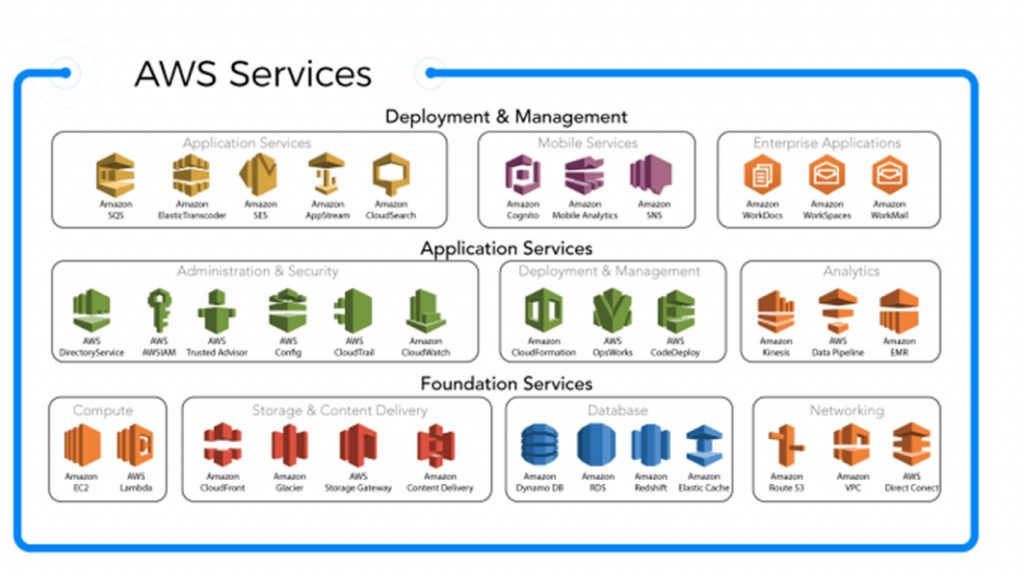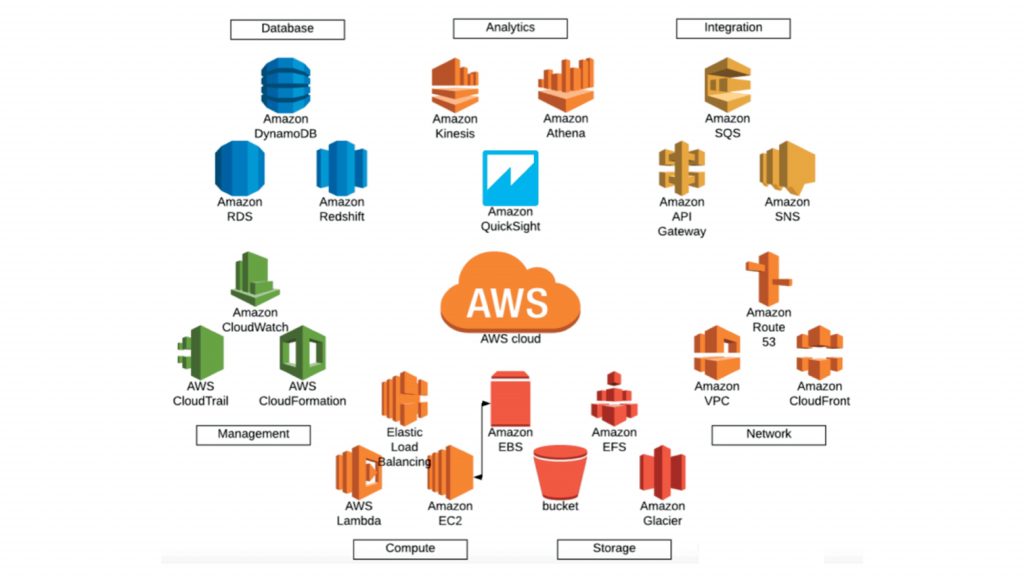
EC2 – Amazon Virtual Servers – EC2 instances are similar to the virtual private servers

S3 – Unlimited FTP Server – Store images and other assets for websites. Keep backups and share files between services. Host static websites. Also, many of the other AWS services write and read from S3.

VPC – Virtual Co-located Lab – Bunch of machines linked together as one VLAN.

Lambda – App Script Container – Run little self contained snippets of JS, Java or Python to do discrete tasks. Sort of a combination of a queue and execution in one. Used for storing and then executing changes to your AWS setup or responding to events in S3 or DynamoDB.

API Gateway – API Proxy – Proxy your apps API through this so you can throttle bad client traffic, test new versions, and present methods more cleanly.

RDS – Amazon SQL – Be your app’s Mysql, Postgres, and Oracle database.

IAM – Users, Keys and Certs – Set up additional users, set up new AWS Keys and policies

Route53 – Amazon DNS + Domains – Buy a new domain and set up the DNS records for that domain.

Cloudfront – Amazon CDN – Make your websites load faster by spreading out static file delivery to be closer to where your users are.

CloudSearch – Amazon Full text Search – Pull in data on S3 or in RDS and then search it for every instance

DynamoDB – Amazon NoSQL – Be your app’s massively scalable key value store

Elasticache – Amazon Memcached – Be your app’s Memcached or Redis.

Elastic Transcoder – Amazon Cut Pro – Video manipulation (change formats, compress, etc.)

SQS – Amazon Queue – Store data for future processing in a queue. The language for this is storing “messages” but it doesn’t have anything to do with email or SMS. SQS doesn’t have any logic, it’s just a place to put things and take things out.

WAF – AWS Firewall – Block bad requests to Cloudfront protected sites.

Cognito – Amazon OAuth – Give end users – (non AWS) – the ability to log in with Google, Facebook, etc.

SNS – Amazon Messenger – Send mobile notifications, emails and/or SMS messages

CodeCommit – Amazon GitHub – Version control your code – cloud Git.

Code Deploy – Get your code from your CodeCommit repo (or Github) onto a bunch of EC2 instances

CodePipeline – Amazon Continuous Integration – Run automated tests on your code and then do stuff with it depending on if it passes those tests.

EC2 Container Service – Amazon Docker as a Service – Put a Docker file into an EC2 instance so you can run a website

Elastic Beanstalk – Amazon Platform as a Service – Move your app hosted on other clouds to AWS

Data Pipeline – Amazon ETL – Extract, Transform and Load data from elsewhere in AWS. Schedule when it happens and get alerts when they fail.

Elastic Map Reduce (EMR) – Amazon Hadoop – Iterate over massive text files of raw data that you’re keeping in S3

Glacier – Large Amazon S3 – Make backups of your backups that you keep on S3.

Kinesis – Amazon Kafka – Ingest lots of data very quickly that you then later use other AWS services to analyze.

RedShift – Amazon Data Warehouse – Store a whole bunch of analytics data, do some processing, and dump it out.

CloudFormation – Amazon Services Setup – Set up a bunch of connected AWS services in one go

CloudTrail – Amazon Logging – Log who is doing what in your AWS stack (API calls).

CloudWatch – Amazon Status Pager – Get alerts about AWS services messing up or disconnecting

Config – Amazon Configuration Management – Keep from going insane if you have a large AWS setup and changes are happening that you want to track.



